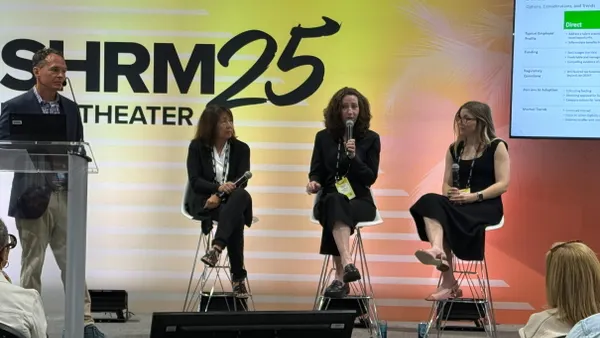Correction: A previous version of this story attributed the phrase "all-in-one platform" to current Zenefits CEO Jay Fulcher. In fact, the phrase was used by former Zenefits CEO David Sacks. It also misidentified Amino. The story has been updated and we apologize for the errors.
When you talk with Colin Rogers, SVP and general manager of benefits solutions at Zenefits, you might get the sense that the benefits administration tech platform/SaaS provider is at something of an inflection point.
If you have been in the employee benefits industry at some length during the past five years, you have heard at least part of the Zenefits story. The company enjoyed massive growth and earned the mantle that is oh-so-cherished by entrepreneurs in Silicon Valley and tech players everywhere: unicorn.
Zenefits was also frequently pegged as a disruptor, a company that would deliver revolutionary tech solutions to small and medium businesses (SMBs) that struggle with the purchasing and delivery of employee benefits.
“As we grew and started to branch out from simple onboarding to broader pieces of the HR puzzle, and then eventually into benefits, obviously we wanted to be able to serve the customer holistically, end-to-end,” Rogers said in a phone interview. “That spawned us becoming the brokerage that we grew over the last three-and-a-half years.”
It’s those small firms, which often lack bandwidth and HR staff, that are specific target partners for the company. Prior to the controversies that beset Zenefits about three years into its existence, the company built off the positive reputation of its platform to attempt to sell employee benefits brokerage services to SMB clients.
Today, the company has been forthcoming about its decision to scrap the title of “broker.” Instead, it has embraced that core technological element, Rogers said.
“If we think back to the very initiation of Zenefits ... [the company] was developed from the first line of code up as a platform, and that's really been the DNA of the company,” he said.
Moreover, Rogers believes there’s a role local brokers play that allows companies like Zenefits to “really maximize the consumer experience.” Brokers help to make the process of helping end-users of benefits (including workers and dependents) understand their options.
“Ultimately, I think on the benefits side of the business, our end goal is to be that platform that connects all of the constituencies and supports the constituency of the client end-to-end,” Rogers said. “That backbone really didn't exist in the small group world prior to Zenefits.”
Standing out
In this industry segment, where new solutions seem to crop up everyday, those types of distinctions have proven invaluable.
It’s gotten to the point in the benefits space that HR practitioners rarely have the time to vet all potential partnerships. Looking across the spectrum from employee wellness to healthcare to retirement planning and all the subcategories in between, it's easy for employers to take on too much at once.
Rogers doesn’t appear to feel intimidated by this complexity, in the competitive sense. Rather, he feels that it’s the type of environment for which Zenefits was built. “If I'm an HR manager looking at the space and trying to decide where to engage in technology, ultimately I want to solve whatever the biggest pain point is for me. That might be payroll, that might be HR, that might be benefits,” he explained.
He continued in saying that the problem with so many focused solutions firms is that they struggle to solve for HR verticals outside of their core competencies.
“The vast majority of [point solutions] when they start to branch out to want to solve for other verticals in this holistic HR picture, they need to bolt on technology, and the integration between them, although somewhat behind the scenes, is really critical,” he said.
Technology-centered platforms like Zenefits are essentially trying to act as the glue that binds these different use-cases together. The pitch is that if you trust Zenefits to develop good tech processes, you can trust it to handle multiple use cases, no matter how varied they are.
Rogers explained that this pitch has played out especially in forming broker partnerships, like the one the company recently announced with benefits agency OneDigital last September. Zenefits now wants to help its broker partners — and the businesses they serve — become more streamlined and efficient using its technology.
The technical capabilities and infrastructure are there, as are the failures and lessons learned. But Zenefits is embracing those, too.
“We're in this very advantageous spot of having gone through the hard work of creating this technology for ourselves and our own business model,” Rogers said, “but also in parallel to that, we're developing this infrastructure that now into the future we can leverage across different constituencies as we focus back on being that core platform.”
What’s next?
Much like other subsets of HR, advanced statistical analysis (often involving "big data") has made inroads into employee benefits.
HR business partners have put considerable dollars into using datasets, including health claims data, to figure out projects as routine as guiding employees to sign up for coverage, and as advanced as walking them through treatment options for breast cancer. Similarly, Zenefits is using its database, built up by years of working with clients, to track key indicators about clients’ workers and their preferences.
Asked about that strategy, Rogers said “the longer-term answer is yes, we'd like to be in the place where our machine is very smart [in] how it can best assist a client across verticals based on what they're doing in any one of those verticals. And we are actually devoting significant resources internally not from a starting point but augmenting what we've already been doing to leverage that data.”
“I see us, as a platform, being an enabler of those leaps forward.”

Colin Rogers
SVP and general manager of benefits solutions, Zenefits
Beyond the data discussion is that of delivery; Zenefits remains committed to a mobile-first strategy. Rogers says admins favor the approach for two reasons: it allows them to step back from having to be the benefits information gatekeeper at all times, and it tends to be “stickier” — employees will keep coming back to something they can easily access on a device they always have on hand.
“Naturally, I'm exposed to more data through use of my mobile device. And in the benefits world, that just naturally leads me to understanding where I am with my benefits,” he said.
In short, there’s a smoothness to it all. At its core, Zenefits wants to be the program that integrates, but also streamlines, different moving parts, functions and capabilities. That sounds similar to language used by former CEO David Sacks, who said in October 2016 that the company would continue to focus on being an “all-in-one platform” that includes areas beyond just benefits.
“The rapidity with which companies like Amino and Castlight are iterating on, developing their ability to expose big data from the industry back out to consumers in a way that meaningfully impacts either treatment or outcomes is a huge plus,” Rogers said. “I see us, as a platform, being an enabler of those leaps forward.”













